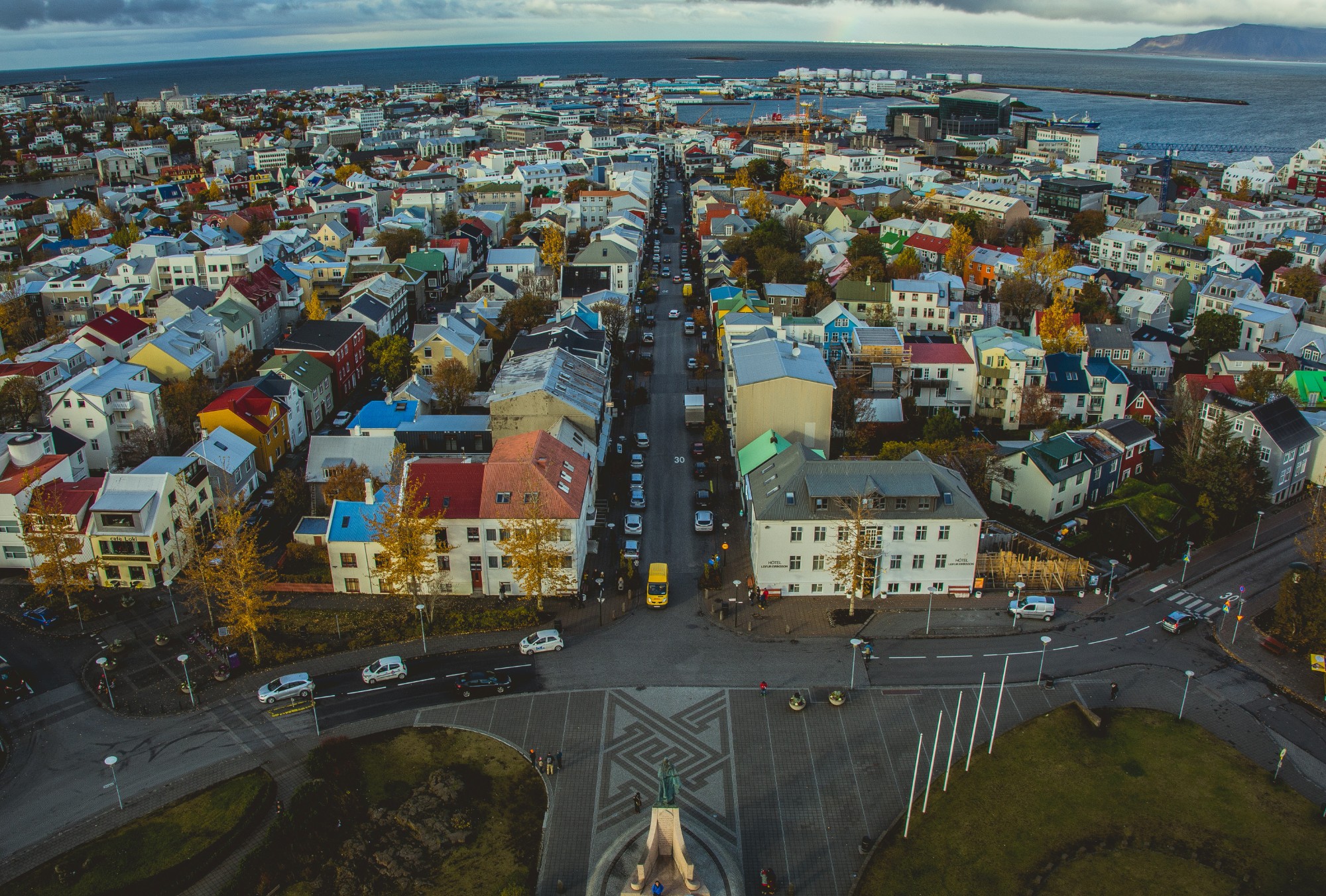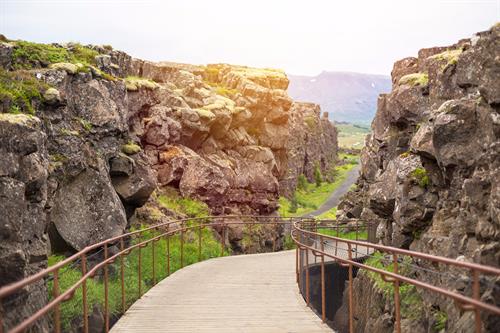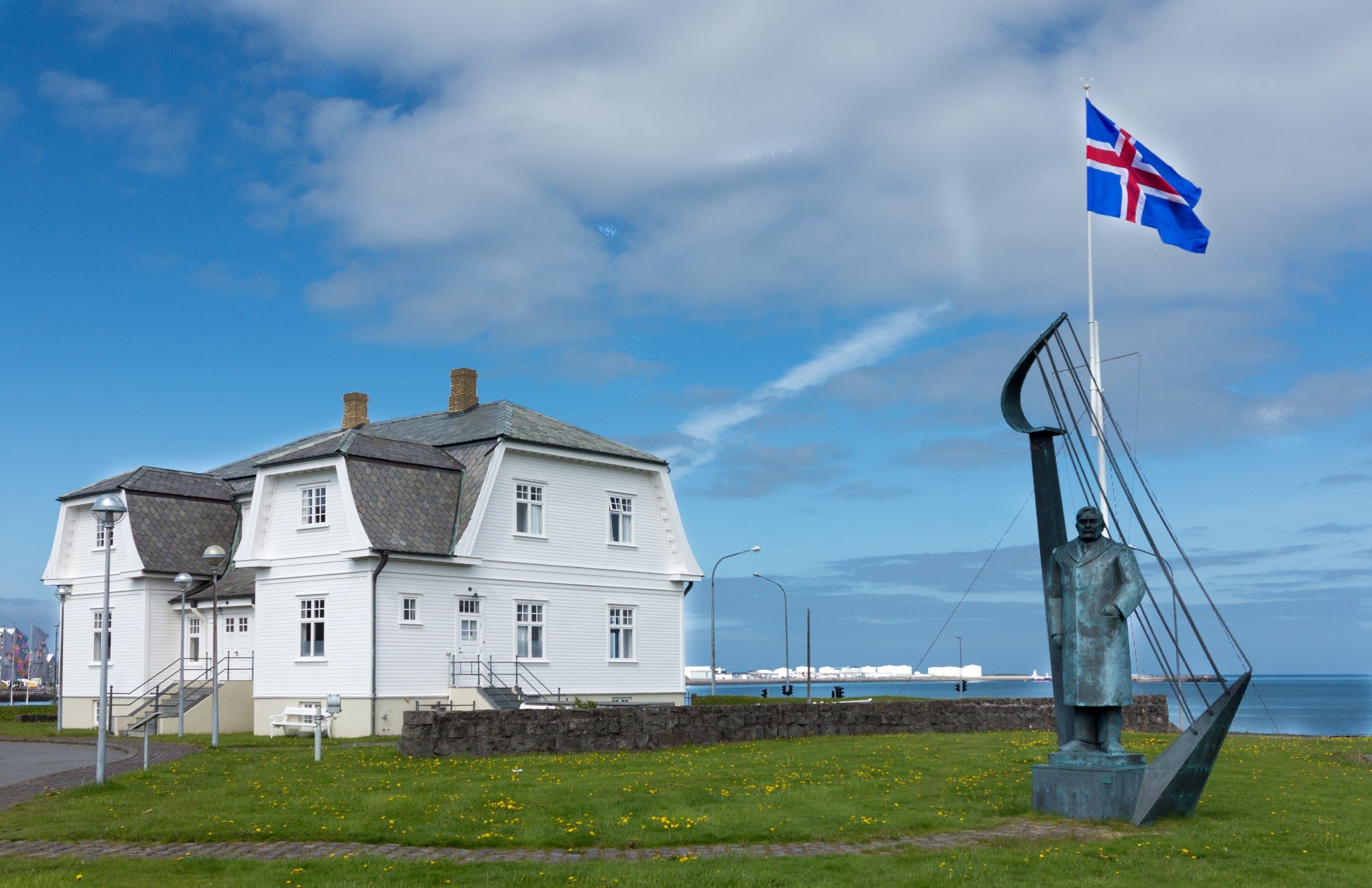Did you know that the name Reykjavik in English loosely translates to “Smoky Bay”?
This name, it is not just a coincidence.
In fact, there is a fun story behind how Reykjavik got its name and it all starts with the first Icelandic settler, Ingólfur Arnarson.
When Ingólfur Arnarson arrived in Iceland in 874 AD he made his home in Reykjavik, but he did not discover Iceland’s capital city by chance. The story goes that when Ingólfur saw the coastline he tossed his high seat pillars into the ocean with the plan that whenever the pillars came ashore is where he would settle. As you can already guess his pillars washed ashore to a place that would then become known as Reykjavik. It is said he gave his new home this name due to the fact that he arrived in a bay, and that there was steam rising from all over, hence the name “smoky bay”, aka Reykjavik.
 View of Reykjavík rooftops
View of Reykjavík rooftops
While this story is largely regarded as legend it is a fun insight into the history behind how Reykjavik got its name. If you are a history buff who enjoys learning stories and other facts like these about places you travel to then this blog post is for you.
In this post we have put together a list of museums, activities, and historical landmarks around Reykjavik that any history buff will enjoy. Add some of these to your Reykjavik itinerary and you will leave Iceland with some fun historical facts to impress your friends with back home!
The National Museum of Iceland
If you only have time to visit one museum while in Reykjavik the National Museum of Iceland is a great option for you. This museum is packed full of information and provides visitors with a detailed overview of the history of Iceland. The main exhibition alone has over 2,000 artefacts!
The museum has a variety of exhibitions ranging from the early days of the Viking settlement all the way to modern times. Displays of artefacts are organized in chronological order making it easy to follow along and see what changes each century brought to the country. In addition to the permanent exhibitions, there are temporary exhibitions that showcase a specific period, activity or equipment from Iceland's history.
At the museum you will also find a photography exhibition. This exhibition is a favorite with visitors, especially those visual learners that like to see a glimpse of history in action versus reading about it. With so many different exhibitions and activities to check out one thing is certain, a visit to the National Museum of Iceland will keep you entertained as you learn about the history of the Icelandic Vikings.
Aðalstræti
Aðalstræti, which translates to “main street”, is the oldest street in Reykjavik where some of the oldest buildings in the city still stand today. It is believed that Iceland’s first settler, Ingólfur Arnarson, had his home on the southern end of the street. There is a lot of history packed into this charming street so be sure to take a stroll in the area.
While you might not realize you are walking down the oldest street in Reykjavik on your first visit here there are still some historically significant locations to see, such as the city’s oldest house, Aðalstræti 10.
Built in 1762, Aðalstræti 10 is one of Reykjavik’s most important houses. Recently the house was opened as a museum so you can visit and learn more about this historical home. In the back of the house there are two exhibitions, “Reykjavik in 1918” and “A Town of Turf Houses.” The Settlement Exhibition, a stop that we will talk about more later in this post, is also located on this street and an entrance ticket to Aðalstræti 10 also gives you access to the Settlement Exhibition.
Alþingi at Þingvellir National Park
While this location isn’t in the city of Reykjavik the 45-minute drive out to Þingvellir National Park is a must for history buffs visiting Iceland. Trust us, the extra drive is for a very good reason as this is the location of the founding of Iceland’s first parliament, which is the oldest surviving parliament in the world!

Þingvellir National Park
When you arrive at Þingvellir you will see a large wooden platform with an Icelandic flag standing high. You might think this location is just a great place for some views over the park, but there is much more history to this exact spot. As you stand on the wooden platform you will learn that you are in the exact location where Iceland’s first parliament (Alþingi in Icelandic) was formed, way back in 930 AD. The Icelandic parliament assembled in this location annually for the first two weeks in June all the way until the 18th century, after which it was then moved to Reykjavik.
A unique historical site that is on the Unesco World Heritage list, be sure to take some time to read further information about the history of the Icelandic parliament that can be found around the wooden platform.
City Walk Tour
Have you ever been walking around a new city and wonder what the history was behind a certain building, or wish you could learn more about the monument you just walked past? With a city walking tour you can do just this, plus learn more interesting facts and the history behind how Reykjavik grew from a few farms to the capital city it is today.
This tour will take you around Reykjavik while you listen to stories about the history of Iceland that you otherwise may not hear about. Find out unique historical facts about different locations in Reykjavik all while seeing the top attractions around downtown. You never know what quirky fact or interesting historical story you will learn on one of these tours. A fun activity for all, even the non-history buffs in your group.
Árbær Open-Air Museum
Learn about daily life for the early settlers with a visit to Árbær Open-Air Museum. At this interactive open-air museum you will explore a village of 20 restored homes that showcase how Icelanders lived during this time. Furthermore, you will see several exhibitions and demonstrations that highlight aspects of daily life during different periods of Iceland’s history.
As you explore the museum you will learn how Reykjavik grew from a village of a few farms to the bustling capital city of Iceland. Museum guides dressed in traditional outfits can be seen wandering around the village so be sure to greet them and get a closer look at the type of traditional garments worn by the early Icelandic settlers.
Plan on spending a few hours at this interesting museum, there is plenty to see and do that will keep all in your group entertained. The museum is open year round with different events happening throughout the year.
Höfði House
Looking out towards the Reykjavik waterfront is Höfði house, one of the city’s historically significant buildings. Built in 1909, Höfði house was initially the location of the French consul but went on to be occupied as a personal family home and then the location of the British Embassy. In 1958 the city of Reykjavik purchased the building and has since been used to host formal receptions and other festive occasions.
 Höfði house
Höfði house
Höfði house is best known for being the location of the summit meeting of presidents Ronald Reagan and Mikhail Gorbatsjov. This meeting became a historical event that was a step towards ending the Cold War. Höfði house became world recognized after images of the house were broadcasted all over the world while the meeting took place.
Höfði house is not open to the public. However, visitors are welcome to explore the outside area of the house. With its historical significance and beautiful views out to the sea, we recommend visiting this charming building during your time in Reykjavik.
The Settlement Exhibition
The Settlement Exhibition is built around the ruins of a Viking longhouse that were discovered in 2001 during building work. The ruins found at this site have been dated back to before 871 AD and are some of the earliest evidence of settlement in Reykjavik. The Viking longhouse that was preserved during the excavation dates back to the 10th century and is one of the oldest man-made structures discovered to date in Iceland.
The Settlement Exhibition is a great activity for all ages to enjoy. Through interactive exhibitions you will learn about the early settlers of Reykjavik in a fun and memorable way. At the exhibition you will also find a children’s play area where the younger ones in your group can enjoy toys and activities based on those used during Iceland’s settlement.
Hofsstaðir Historical Park
Located just outside of downtown Reykjavik in the town of Garðabær is Hofsstaðir Historical Park. Here you will find a Viking age longhouse dating back to 870-930 AD. At first glance, one might think the area is just a park and pass it without knowing of its historical significance. Don’t make that mistake! This longhouse is one of the largest discovered in Iceland. At the park, you will see turf walls that show the outer limits of the longhouse still standing, as well as the remains of an enclosure that has been left untouched.
Hofsstaðir is not a well-known location and was only discovered by accident in 1986 during construction in this area. Not many know about this location making it a hidden gem that any history buff will want to discover while in Reykjavik. While the interactive exhibitions at this location are currently unavailable a visit here will make for a unique experience and be a fun way to get a look at the type of homes the early settlers lived in.
Bessastaðir
An area that has a history that dates back to the age of Settlement, Bessastaðir has another factor that adds to its significance for it is the official residence of Iceland’s president. Located on the low lying peninsula just east of Reykjavik, the recognizable white buildings with red rooftops at Bessastaðir can often be seen on a clear day from parts of Reykjavik.
While Bessastaðir has a significant role in today’s Icelandic society, the history of this area dates back to the 13th century when the famous writer Snorri Sturluson had a farm here. Mentioned in the Icelandic sagas, later archaeological digs have discovered evidence that shows that Bessastaðir was settled by some of the earliest settlers in Iceland.
To visit Bessastaðir you do need an invitation or an organized visit, however, the general public is welcome to drive around this area and even visit the church that is on the property. The landscape here is an added bonus with the ocean surrounding the peninsula, mountains in the distance, and the beautiful Reykjavik skyline in view, it makes for a special activity to do in Iceland.
101 Area Code
If you are visiting Reykjavik it is very likely that you will be spending some time in the lively downtown area. But did you know that the quirky downtown area of Reykjavik, known as the 101 area code, is also the oldest area of the city? In this famous neighborhood you will find charming colorful houses to admire, small streets to explore, and several historical buildings and locations to visit.
While you explore downtown here are a few historically significant locations that are not on this list to check out:
Dómkirkjan (Reykjavík Cathedral) - Built in the late 17th century, this is the oldest church in Reykjavik and is located close to the Icelandic parliament.
Old Harbor - While not the oldest area of Reykjavik, the old harbor’s construction in 1913-1917 marked a change in life for Icelanders as the fishing and trade industry grew dramatically once the harbor was completed.
Hólavallagarður Cemetery - Nominated as one of Europe’s loveliest cemeteries by the National Geographic, many notable Icelanders are buried here such as independence movement leader Jón Sigurðsson, and the oldest grave dates back to 1838.
Interested in learning more about the history of Iceland? Check out this post for all about the history of how Iceland became an independent republic. And for more ideas of what to do in Reykjavik read some of our other articles all about Reykjavik.